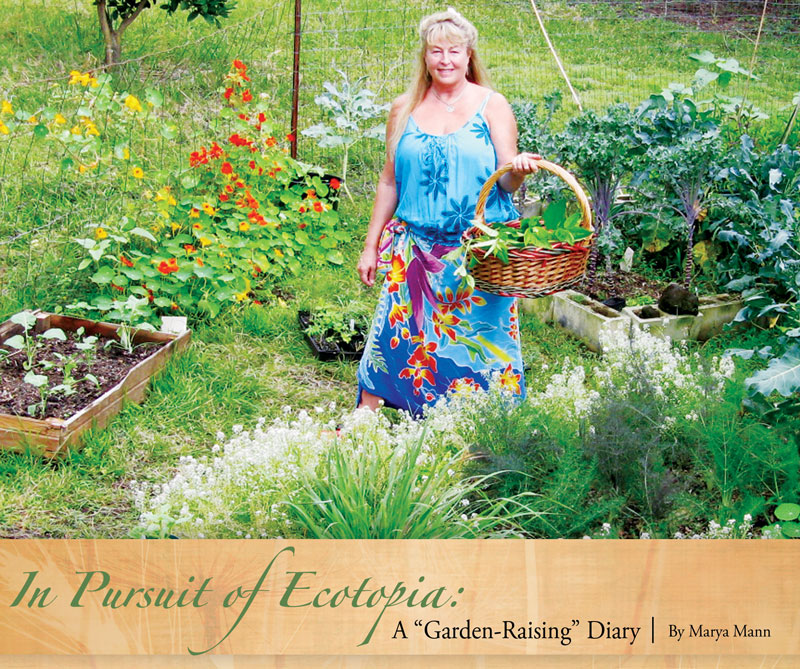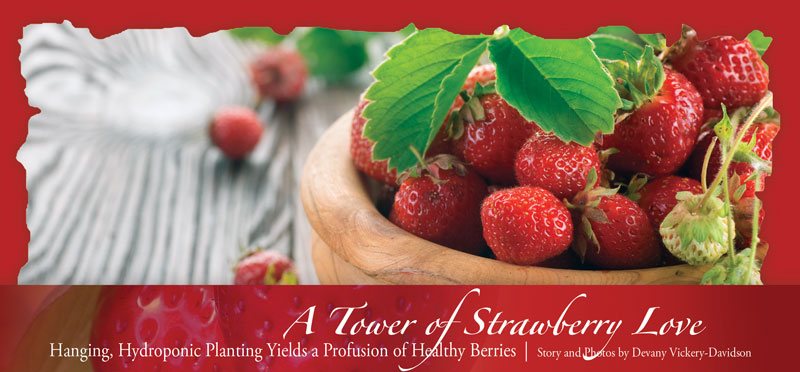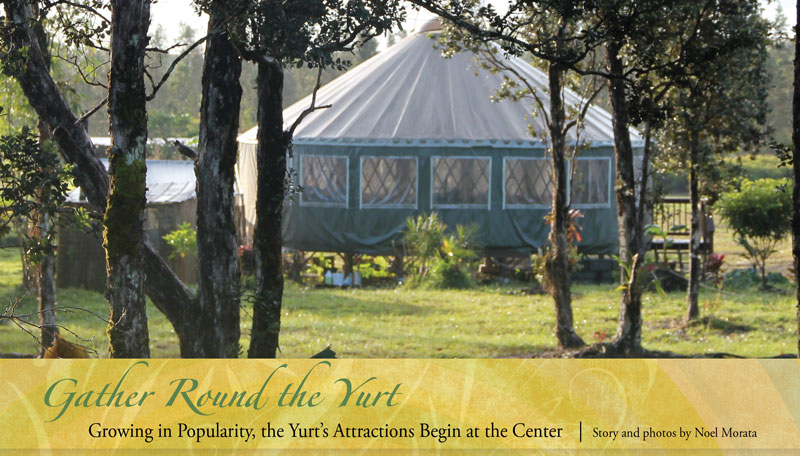
In Pursuit of Ecotopia: A “Garden-Raising” Diary

By Marya Mann
Most of my life I have gardened, a vocation for which I credit my grandmother Ina. In old photographs of her home in the West Texas Panhandle, vertical stands of lacy asparagus and succulent butternut squash on vines shoot out in lime green curlicues. No-nonsense as she was, she planted seeds believing love would blossom. Orange pumpkins, scarlet tomatoes, Mexican chili peppers and black-eyed peas were her specialties, cultivated with the charm of a plant whisperer in the fickle wilds of Texas.
While she fought rattlesnakes, I live on a tropical island where there are no snakes (except the ones we create in our minds). From our kitchen garden 1,200 feet above Honokohau Harbor on Hulalalai Volcano, I gaze west to the fuzzy indigo horizon that seamlessly blends sea and sky.
With two 4 x 16-foot garden beds to keep, I don’t pause for long.
Help from Josanna’s Garden
Six months ago, Janelle Honer sat with me in her Kapoho kitchen and described what a tropical Hawaiian garden could be, producing good food, health and beauty year-round. “If your every morning takes you outdoors to your small, family-sized garden to pick your own food and practice sun salutes, it’s a very different kind of life,” she said. As the heart and center of an eight-acre certified organic food farm, her kitchen brims with colorful activity—workers, friends and family talking story about the magic of gardening, the future of food, companion planting and natural pest control in the vivid rainforest of Puna.
Reaching her hand to the floor and sweeping it up in the air like a magician, she conjures for me the vision of how easy it will be to build up the soil in my Kona backyard and effortlessly produce fresh food, useful plants and edible flowers. Rather than try to dig through the lava, she says, “Add soil. Either have it delivered or go pick some up. You’ve got to build up the soil with compost, too,” she said. “It’s that simple.”
On her Josanna’s Organics farm, she grows golden turmeric and giant galangal (a ginger-like seasoning for Thai food) for natural food restaurants in Hawai‘i and on the Mainland. Every scrap of life is sacred here on the fertile ground named in memory of her dearly beloved daughter, Josanna Morningstar, who died in 2005.
From the moment we reconnected on-island five years ago, I was awed by Janelle’s farm and how, without the use of genetically modified organisms (GMOs), pesticides or chemical fertilizers, Janelle grows bumper crops of wholesale organic spices as well as fruits and vegetables to feed her extended ‘ohana and stock their Papaya Farms Road foodstand.
Six months ago, Janelle offered to help our garden along with an event akin to an old-fashioned barn-raising: a garden-raising.
Touching Ground
When my family moved to the site of our current Kona garden, previous dwellers had lined the plots with cinder blocks, one of the easiest, fastest ways to start a garden. Surrounded by a wire fence to protect it from a feral flock of turkey and our neighbor’s Rhode Island Reds, the kitchen garden was our wished-for miracle, a space to feel nature. Even though the beds were clotted with cane grass and weeds, volunteer tomatoes, yams and natives unknown to me grew profusely, mostly outside the actual beds.
My hands were deeply grateful to burrow in the rich soil after living several years in Hawai‘i with only container gardening. Something in a human being simply breathes more easily when regular contact with the actual earth is a daily affair. In every other garden I’ve grown, from Boston to Bali, I’ve started from seeds and often didn’t think I had space for composting.
Over the years, I did learn that the gravitational pull of the moon affects moisture in soil, so that at different phases of the moon, certain crops should be planted. I also learned there are exceptions to every rule. With the exception of gravity, rules are relative.
We could plant leafy flowering plants at the “wrong” time or place, but with the right attitude, and life would flourish. I noticed how my cooing and wonder over the spinach plants and patting down the pepper sprouts yielded a value to my life as well as the plant’s.
Layers of Wisdom
On a pristine September day, Janelle arrived in Kona with her station wagon full of perky, green plants in three flats: a dozen fennel, five parsley, a lemongrass, countless varieties of basil, four tomato, and six tiny alyssum starts.
We had prepared the beds with added topsoil and organic fertilizer. Noting our compost-pile-in-process, Janelle reminded us: “Good compost, rich soil, healthy plants.” All table scraps, carrot tips, fried rice, coffee grinds, teabags — all but dairy, meat and fish — plus plant clippings and leaf trimmings, make the best biomass for the compost.
“Understanding the structure of soil and how it works for you will give you a lot more volume of food for a small amount of space,” she said, citing the bio-gardener’s motto: start with biomass, let it rot, and micro-organisms grow. “They’re called inoculants. When the compost starts growing and wiggling, it’s getting good,” she says with hearty laughter. “You should be thinking about feeding your soils all the time, especially if it’s your own little vegetable garden.”
She suggested we lay in old cardboard as mulch between rows and slide plants in between the pieces. Cardboard helps the soil hold moisture while suppressing weeds, and it slowly breaks down to supply carbon to the plants’ roots. What a blessing, from a cardboard box!
Healers at Our Feet—Coming Full Circle
Love and friendship nurture the best kind of seed, ‘ano’ano in Hawaiian. Such seeds grow more than gardens; we cultivate ‘ohana, family.
Here in Hawai‘i, kitchen gardens, eating naturally, sharing aloha and getting plenty of exercise—the real healers in the health care crisis—appear more real than stress-induced depression epidemics and surgical missile strikes.
The deep, green surgery that will truly heal our ailing world is at our feet, offered to our fingertips and palates. Emerald green Okinawan spinach has begun to trail in a dozen sunbursts over two rows of our small food plots, and an unidentified flying squash poses on the fence wire.
Kneeling down in the “harvest yoga” posture, I lift my scissors, poised to clip long slender kale from their chest-high bamboo-like stalks. We are like sisters on the journey, kale and I. I ask and she gives. She asks and I give. An indescribable energy exchange occurs. By giving thanks, I receive nutrition and something more: the willingness to also clip any of my thoughts or actions which don’t belong in this new earth. Clip, clip, clip.
The exhilaration of another nature-rich day on Hawai‘i Island reminds me of reading long ago in The Secret Life of Plants that when Kirlian photography captures the electromagnetic field of a tiny acorn, the aura radiating from the seed is in the shape of its future self, the larger oak tree.
Today feels like an oak tree kind of day.
Six Months Late—The Master Gardener Returns
Kale, peppers, fennel, tomatoes, flowers and garden beds have somehow multiplied. We added a recycled cedar board bed for a second crop of broccoli and tall yellow sunflower plants. We’re laying out cinder-block beds for the15 lavender sprouts Janelle just brought from Josanna’s Organics, free of coqui-frogs and full of vigor. Alyssum spreads in knee-high pincushions of honey-smelling pest control. Rows of sweet potato, turmeric, and green beans join rosemary and edible hibiscus in our food supply, while begonias, marigolds and bougainvillea add beauty.
The lime-colored escarole is bitter, but Janelle says I can mix it up with ginger and soy sauce for a nutritious sauté’. Most fruit is alkalizing, even citrus, which also has an excess of fruit sugars. It needs to be balanced with bitter greens, for their grounding, cleansing effects, otherwise sugars will feed excess bacteria.
She helps me install Italian heirloom lettuce, sorrel and sage. The lavender we can set aside to plant next week, knowing its happy scent and the teas made of Janelle’s lemon balm plant will help us relax, restore focus and improve memory.
Her eyes light up like two supermoons when she sees our flowering nasturtium patch. “You have nasturtium. I want some seeds.” Golden and orange nasturtiums are life-long buddies. Peppery-tasting and colorful, they are among the first seeds I have always planted around my kitchen gardens, and I have never had to spray anything harmful. Nasturtium fends off bean aphids and cabbage loopers while climbing fence posts and putting on a humble little art show.
“Here they are,” she says, reaching under the circular leaves to find 50 or 60 nasturtium seed pearls scattered on the ground.
“It’s really unusual that after six months you already have a second generation of seeds to share,” Janelle says.
“Take as many as you want,” I say. “They’ll keep producing.”
Bumper Crop Bonding—Green Ancestors
I’m just a backyard gardener at the gates of paradise, but I saw those same two supermoon eyes illuminate the face of my step-daughter when we handed her ceramic pots of second-generation fennel, basil and parsley plants for her downtown apartment’s lanai.
Janelle’s garden-raisings have instilled in me more passion and reverence for all of nature. My family lives on less than we used to, but we feel more abundant and prosperous. Choosing purchases and practices with the lowest carbon footprint and “bio-identical eating”—ingesting only what’s natural to the body—we feel more kinship with the whole ecosystem.
I arise every morning at first light and aim my body toward the garden. Gliding out the back door, I am greeted by the cheer-cheer-cheers of yellow-billed cardinals singing in banana, grapefruit and mango groves. Meyer’s lemon trees with waxy emerald leaves dance in the breeze. I look down around our ahupua’a toward Holualoa Bay. I enter the garden quietly, for here is a teacher, a temple, a family, a space to restore myself, like conversation with a wise auntie, a sister, brother, grandparent, lover, or a life-long friend.
Two days after Janelle brought lavender plants, the bunches of bitter escarole unexpectedly blossomed—with lavender flowers, and when I looked mauka that same morning, the jacaranda tree up in a fold of the green slope had bloomed—in the exact same whisper of lavender.
Garden-raisers, unite! Let’s raise some heather together!
Resources:
Find Janelle Honer at Josanna’s Organics Garden and Fruit Stand on Papaya Farms Road. 808.640.2157, Garden-Raisings
The Tropical Food Security Garden
Photos by Koakane Green


